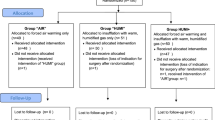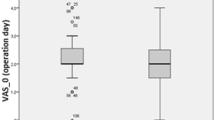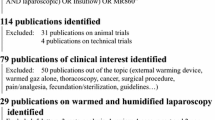Abstract
Background: Intraoperative hypothermia is a common event during laparoscopic operations. An external warming blanket has been shown to be effective in preventing hypothermia. It has now been proposed that using heated and humidified insufflation gas can prevent hypothermia and decrease postoperative pain. Therefore, we examined the extent of intraoperative hypothermia in patients undergoing laparoscopic Nissen fundoplication using an upper body warming blanket. We also attempted to determine whether using heated and humidified insufflation gas in addition to an external warming blanket would help to maintain intraoperative core temperature or decrease postoperative pain. Methods: Twenty patients were randomized to receive either standard carbon dioxide (CO2) gas (control, n = 10) or heated and humidified gas (heated and humidified, n = 10). After the induction of anesthesia, an external warming blanket was placed on all patients in both groups. Intraoperative core temperature and intraabdominal temperature were measured at 15-min intervals. Postoperative pain intensity was assessed using a visual analogue pain scale, and the amount of analgesic consumption was recorded. Volume of gas delivered, number of lens-fogging episodes, intraoperative urine output, and hemodynamic data were also recorded. Results: There was no significant difference between the two groups in age, length of operation, or volume of CO2 gas delivered. Compared with baseline value, mean core temperature increased by 0.4°C in the heated and humidified group and by 0.3°C in the control group at 1.5 h after surgical incision. Intraabdominal temperature increased by 0.2°C in the heated and humidified group but decreased by 0.5°C in the control group at 1.5 h after abdominal insufflation. There was no significant difference between the two groups in visual analog pain scale (5.4 ± 1.6 control vs 4.5 ± 2.8 heated and humidified), morphine consumed (27 ± 26 mg control vs 32 ± 19 mg heated and humidified), urine output, lens-fogging episodes, or hemodynamic parameters. Conclusion: Heated and humidified gas, when used in addition to an external warming blanket, minimized the reduction of intraabdominal temperature but did not alter core temperature or reduce postoperative pain.
Similar content being viewed by others
Author information
Authors and Affiliations
Rights and permissions
About this article
Cite this article
Nguyen, N., Furdui, G., Fleming, N. et al. Effect of heated and humidified carbon dioxide gas on core temperature and postoperative pain. Surg Endosc 16, 1050–1054 (2002). https://doi.org/10.1007/s00464-001-8237-0
Received:
Accepted:
Published:
Issue Date:
DOI: https://doi.org/10.1007/s00464-001-8237-0




